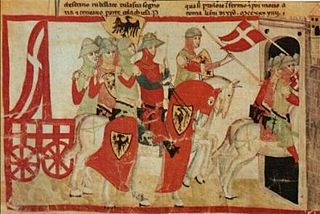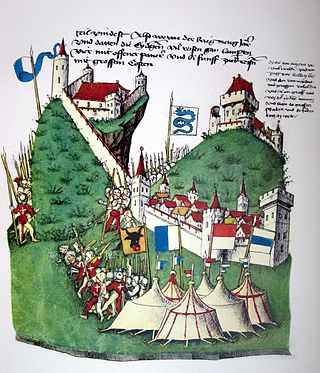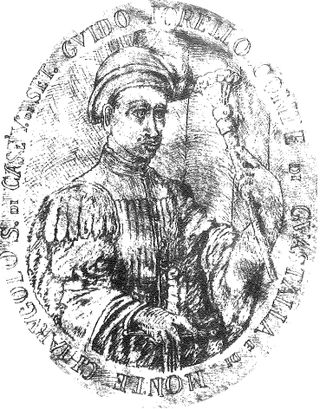Battle
In the late evening of 21 June 1431 the Milanese fleet attacked the Venetian one on the Po near Cremona but five galleons of the former, detached from the rest of the fleet, were soon surrounded and captured, then darkness temporarily ceased hostilities. Francesco Sforza and Niccolò Piccinino, informed of what had happened, decided to board the ships at night together with the most chosen militias and to prevent Carmagnola from imitating them, they sent two spies to the Venetian camp with the task of spreading the word that Piccinino, in dawn, would have attacked them. At the first light of dawn on 22 June, the Milanese fleet engaged the Venetian one which did not expect to be attacked again after the defeat of the previous evening. The battle lasted about 12 hours and took place on the stretch of river just downstream from the city of Cremona. To try to avoid defeat, Trevisan several times sent messengers to Carmagnola to come to his aid but these, fearing a surprise attack by Piccinino, decided not to intervene. Many Venetian gelee, larger and with a greater draft than the Milanese ones, ran aground on the scree of the river and were easily captured, including the flagship of the Trevisan. Having lost all hope of victory, Trevisan decided to withdraw with what remained of the Venetian fleet. [11]
Aftermath
The Venetians lost 28-29 galleons and 42 minor ships, 9,000-11,000 men between dead and prisoners, 60,000 ducats ready to pay the troop pay, 1,500 hand cannons, 2,000 cuirasses and as many crossbows together with banners and provisions with an estimated damage around to 600,000 guilders. During the battle a quarrel severely wounded Niccolò Piccinino in the neck severing his nerves and making him lame for the rest of his life. But the defeat blocked the operations of the entire Venetian army, given that the Venetian authorities considered it imprudent to cross the Adda, the last line of defense for Milan, without the support of a river fleet, and thus the entire war campaign was nullified. from Carmagnola until then. The Venetian ships captured by the Visconti fleet were brought in triumph to Pavia (headquarters of the Visconti fleet), where they were still on display in the 16th century. [11]

The Battle of Cortenuova was fought on 27 November 1237 in the course of the Guelphs and Ghibellines Wars: in it, Holy Roman Emperor Frederick II defeated the Second Lombard League.
Pietro Loredan was a Venetian nobleman of the Loredan family and a distinguished military commander both on sea and on land. He fought against the Ottomans, winning the Battle of Gallipoli (1416), played a leading role in the conquest of Dalmatia in 1411–1420, and participated in several campaigns against Venice's Italian rivals, Genoa and Milan, to secure Venice's mainland domains (Terraferma). He also held a number of senior political positions as Avogador de Comùn, ducal councillor, and governor of Zara, Friuli, and Brescia, and was honoured with the position of Procurator of St Mark's in 1425. In 1423, he contended for the position of Doge of Venice, but lost to his bitter rival Francesco Foscari; their rivalry was such that when Loredan died, Foscari was suspected of having poisoned him.

The Golden Ambrosian Republic was a short-lived republic founded in Milan by members of the University of Pavia with popular support, during the first phase of the Milanese War of Succession. With the aid of Francesco Sforza they held out against the forces of the Republic of Venice, but after a betrayal Sforza defected and captured Milan to become Duke himself, abolishing the Republic.

The Battle of Curzola was a naval battle fought on 9 September 1298 between the Genoese and Venetian navies. It was a disaster for Venice, a major setback among the many battles fought in the 13th and 14th centuries between Pisa, Genoa, and Venice in a long series of wars for the control of Mediterranean and Levantine trade.

The Battle of Meloria was fought near the islet of Meloria in the Ligurian Sea on 5 and 6 August 1284 between the fleets of the Republics of Genoa and Pisa as part of the Genoese-Pisan War. The victory of Genoa and the destruction of the Pisan fleet marked the decline of the Republic of Pisa.
The military history of the Republic of Venice started shortly after its founding, spanning a period from the 9th century until the Republic's fall in the 18th century.

The Battle of Anghiari was fought on 29 June 1440, between the forces of Milan and the League of some Italian states led by the Republic of Florence in the course of the Wars in Lombardy. The battle was a victory for the Florentines, who secured their domination of central Italy.
Bartolomeo Minio was, among other things, a Venetian captain and commander of Napoli di Romagna, a Venetian outpost on the Morea (Peloponnese) from 1479 to 1483. His reports (dispacci) to Venice provide a unique historical source for southern Greece in the later 15th century, during the first decades of the Ottoman occupation.

The Wars in Lombardy were a series of conflicts between the Republic of Venice and the Duchy of Milan and their respective allies, fought in four campaigns in a struggle for hegemony in Northern Italy that ravaged the economy of Lombardy. They lasted from 1423 until the signing of the Treaty of Lodi in 1454. During their course, the political structure of Italy was transformed: out of a competitive congeries of communes and city-states emerged the five major Italian territorial powers that would make up the map of Italy for the remainder of the 15th century and the beginning of the Italian Wars at the turn of the 16th century. They were Venice, Milan, Florence, the Papal States and Naples. Important cultural centers of Tuscany and Northern Italy—Siena, Pisa, Urbino, Mantua, Ferrara—became politically marginalized.

The naval Battle of Vila Franca do Campo, also known as Battle of Ponta Delgada and Naval Battle of Terceira Island, took place on 26 July 1582, off the coast of the island of São Miguel in the Portuguese archipelago of the Azores, during the War of the Portuguese Succession. A combined corsair expedition, mainly French, sailed against a Spanish naval force made up of Portuguese and Castilian ships, to preserve control of the Azores under the pretender António, Prior of Crato and to defend the islands from incorporation into the Iberian Union, the largest French force sent overseas before the age of Louis XIV.

The Battle of Delebio took place during the Wars in Lombardy. It occurred on 18 and 19 November 1432, near Delebio, in the Valtellina. It was an aftermath of the occupation of Brescia and the Valle Camonica by the armies of the Republic of Venice, led by Francesco Bussone, Count of Carmagnola.

The Battle of Arbedo was fought on 30 June 1422 between the Duchy of Milan and the Swiss Confederation, and ended with a Milanese victory.

Francesco Piccinino was an Italian condottiero.

Şuluk Mehmed Pasha, better known in Europe as Mehmed Siroco or Mahomet Sirocco, and also spelled Sulik, Chulouk, Şolok, Seluk, or Suluc and known with the titles Pasha, Reis, or Bey, was the Ottoman Bey of Alexandria in the mid-16th century. Both the foreign and the Turkish nicknames were derived from the name of the southern Mediterranean wind Sirocco, from Greek σιρόκος sirokos and the hence derived Levantine Arabic شلوق shlūq, respectively.
Alvise Loredan was a Venetian nobleman of the Loredan family. At a young age he became a galley captain, and served with distinction as a military commander, with a long record of battles against the Ottomans, from the naval expeditions to aid Thessalonica, to the Crusade of Varna, and the opening stages of the Ottoman–Venetian War of 1463–1479, as well as the Wars in Lombardy against the Duchy of Milan. He also served in a number of high government positions, as provincial governor, savio del consiglio, and Procuratore de Supra of Saint Mark's Basilica.

Pier Maria Rossi or Pier Maria II de' Rossi was an Italian condottiere and count of a region around present San Secondo Parmense. His properties included the castle of Rocca dei Rossi. He was known as "the Magnificent".

Galeas per montes is the name given to a feat of military engineering made between December 1438 and April 1439 by the Republic of Venice, when several Venetian ships, including galleys and frigates were transported from the Adriatic Sea to Lake Garda. The operation required towing the ships upstream on the river Adige until Rovereto, then transporting the fleet by land to Torbole, on the Northern shores of the lake. The second leg of the journey was the most remarkable achievement, requiring a land journey 20 km through the Loppio Lake and the narrow Passo San Giovanni.
The Battle of Constantinople was a naval battle between the fleets of the Empire of Nicaea and the Republic of Venice that occurred in May–June 1241 near Constantinople.

The Castle of Pontevico is a former fortification built at the height of the early Middle Ages in Pontevico, Province of Brescia, currently used as a neuropsychiatric institute. It has also been remodeled several times over the centuries, due to the continuous sieges suffered over time. It was completely rebuilt in 1844, and the current version dates from the second half of the 20th century.

Guido Torelli was a condottiero. Through his military campaigns and diplomatic skills, he achieved the title of the first Count of Guastalla and Montechiarugolo.













